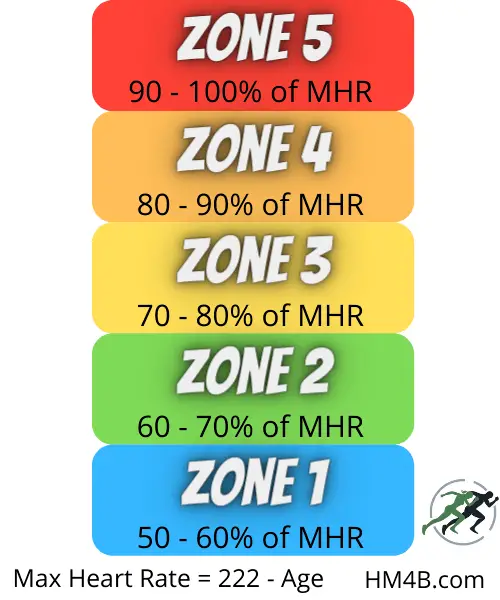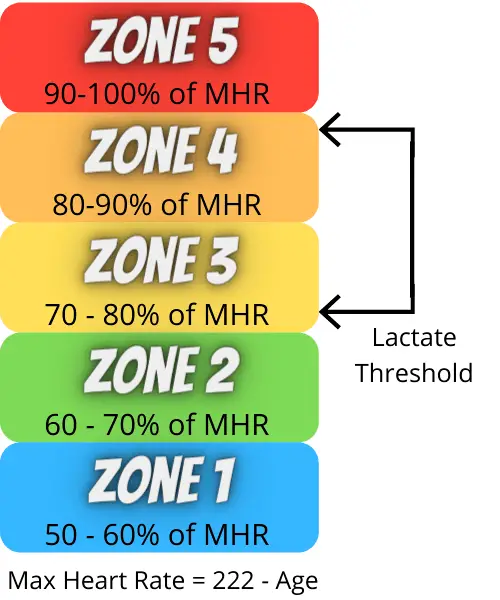While you will often think that most runners will be judging their performance based on the pace they are keeping, there is actually another way for runners to keep track of how they’re doing. Known as heart rate zone training, this technique is used to help guide the level of intensity during your exercises and gauge your levels of energy.
Every serious runner needs a smart method to keep track of how they are performing in their workouts. Thanks to the advent of wearable health devices such as the Fitbit with access to heart rate functions, it has never been easier to keep track of your heart rate during exercises.
In fact, incorporating a heart rate training mentality in your exercise might be one of the best things you can do to keep up with how you are doing while out on a run.
What is Heart Rate Zone Training?
Heart rate zone training uses your heart rate (in beats per minute, or BPMs), as your guide to how intense your workout is. It is often sometimes measured in percentage form, using your maximum heart rate (or MHR) as a way to tell how you are doing.
When using this style of training, a runner will gauge their heart rate using a heart monitor as they train, placing themselves in specific heart rate zones depending on how intense their workout might be.
What Are the 5 Heart Rate Zones?
To better understand Training zones for runners – what are they (heart rate zones), you need to be aware of the five different heart rate zones and how each level changes your workout. Once you know how these of these zones work, you will be able to easily incorporate this kind of training into your own runs, if you would like.
Zone 1: Low Intensity (50-60% of MHR)
In this zone, you should be able to comfortably carry on a conversation during your exercise. This is the zone where you will be able to train to move onto the higher zones. To get started in the first zone, choose a low-intensity exercise that you are comfortable doing that won’t increase your heart rate exponentially. A few good examples you could try include walking or bicycling.
Zone 2: Light Intensity (60-70% of MHR)
In this zone, you should feel a little more challenged, while still feeling like you could go on for hours at this pace. Zone 2 is known for building up endurance, allowing your body to get used to exercising for longer periods of time and burning fat while building muscles.
Zone 3: Moderate Intensity (70-80% of MHR)
This zone is best for improving efficiency and building up blood circulation. This zone is also going to be good for working on developing your skeletal muscles. Train for a bit in this zone, and you will be prepared to move up to heart rate zone 4.
Zone 4: High Intensity (80-90% of MHR)
This zone is where things really start to heat up for your exercise. At this intensity, you will be working on your breath and aerobics, due to heavier, more intense workouts and the heavier breathing required. Training at this level will help build up speed, endurance, and hopefully, the ability to continue training without feeling like you are giving out.
Zone 5: Maximum Intensity (90-100% of MHR)
This is where things get really serious in your workout. All of your systems, including cardiovascular, respiratory, and more will be working at their maximum levels. After a bit, you likely won’t be able to continue at this intensity comfortably.

What is MHR, and Why is it Important to Runners?
MHR is simply a short way of saying “Maximum Heart Rate,” and it is important for runners practicing heart rate training exercises. This is because when using heart rate zone training as a guide for your exercise, you can use your MHR as a way to tell how intense you are getting with your workout.
For example, someone in zone 1 is going to be much more relaxed during their workout than someone in zone 5, who is going to be training at maximum capacity, using all of their body’s systems.
Does Orange Theory Training Use MHR?
Yes – Orange Theory uses heart rate zone training extensively. Most of the exercises you will find with Orange Theory Fitness involve monitoring heart rates, including heart-rate-based cross-training exercises such as treadmill training, indoor rowing, weight training, and of course, running.
How Do You Calculate Heart Rate Zones For Running?
There are several tools for calculating your heart rate, including online MHR calculators, but the best way for you to discover yours is to simply get out and start running while using a piece of equipment that can help you gauge your heart rate in real-time. A Fitbit or other smartwatch with heart-rate tracking capabilities is a good option to use here.
Begin by warming up, and then build up a pace that you think you would be able to hold for at least 20 minutes. You can then check your monitor – your MHR value should be at least 10 beats higher than the one you took note of on your display.
You can also look at your MHR another way – subtracting your age from 220. For example, if you are 50 years old, you would subtract 50 from 220, making your MHR 170 bpm.
What Type of Training Should Be Done in Each Zone?
The level of intensity in each zone can help influence what kind of training you will go through while in that zone. Here are the kinds of exercises you can continue doing in each zone:
- Zone 1: Exercises in this zone should be mainly for warming up or cooling down.
- Zone 2: In this zone, you should still be able to converse with a workout partner comfortably while continuing on your workouts.
- Zone 3: In this zone, you should be building up your strength and speed – conversation might be a little more limited in this zone – mainly short sentences.
- Zone 4: This zone is using your body’s lactic acid as a way to keep you fueled. Also, labeled your lactate threshold zone. The peak of this zone normally breaks through the lactate threshold if running continuously. In this zone, you should be running at your maximum pace while still building endurance and efficiency. Only words here and there – conversation is difficult at this pace.
- Zone 5: This is the maximum zone – your body will learn how it should be using muscles and fibers effectively in this zone as you push yourself to the limit. This is also known as your anaerobic training zone. Your body can only run in this zone for a matter of minutes before you fatigue.

Pros of Heart Training Zones
There are several advantages to choosing to work out in this way:
- Using this kind of training is able to help you learn to control in your exercise.
- Heart rate training shows you how your body is able to respond in various situations.
- Heart rate training is a good way to gauge improvement in your workout.
Cons of Heart Training Zones
Of course, there are also some drawbacks to choosing to work out in this way:
- Some heart rate monitoring tools might not be the most reliable.
- You need to memorize your zones for them to be most effective.
Is it Good to Have a High Heart Rate While Running?
A high heart rate can be a great indicator that you are engaging in higher amounts of physical activity. However, it might not be the best thing for someone who is brand new to this kind of exercise, due to the fact that going higher than your maximum heart rate allows can pose a threat to your health.
Related: 12 Health Benefits Of Running You Shouldn’t Ignore!
Is it Bad to Exercise at 170 BPM?
This depends entirely on whether you are familiar and comfortable in this zone. Some athletes may routinely work themselves to the point of 170 bpm and higher when exercising. The trick is to know which zones you are comfortable in and trying not to exceed it until you think you are ready.
How Do I Lower My Heart Rate While Running?
When you are running, if you think you are reaching an MHR you are not comfortable with, you might want to practice bringing your heart rate down during your exercise. To do this, you can try a few simple tricks:
- Get into a steady breathing rhythm as you run
- Bring your mind at ease while running, don’t stress about it
- If needed, slow down to a walk until you feel comfortable picking up the pace
What Happens if You Exceed the Maximum Heart Rate?
Going above your target heart rate during your exercise could bring some unenjoyable things into your life, including sore joints, muscles, and feeling tired. You could put yourself at risk from training too much if you continue like this, which might make you avoid exercising together.
For best results, always try to stay in the range of your target heart rate while exercising, and only move up in zones when you are comfortable.
Should My Heart Rate Go Over 200?
It is entirely possible for your heart rate to go over 200 bpm during exercise. However, if this is not normal for you, you will probably want to scale back down to a lower MHR.
Will You Take Advantage of Heart Rate Zone Training?
As you can see, there are all kinds of reasons to think about incorporating heart rate zone training into your exercise. It can help you measure how you are doing, work out to your best capacity, and get a good idea of how you should be doing for someone in your age range.
At any rate, it can be a good way to judge how you are doing in your running, and that can be an invaluable resource to any serious runner.
Related: 11 Reasons Why Your Running Performance Might Not Be Improving.
| Help support me and subscribe to my YouTube channel. YouTube video - 30 ways to make your runs less painful! Coach Scott's Credentials:
|
To sign up for a FREE half marathon training schedule, log sheet, and pace predictor CLICK HERE.

Recommended gear for runners
Connect with me:
| facebook.com/BeginnerToFinisher/ |
References
calculating MHR: https://www.polar.com/blog/calculate-maximum-heart-rate-running/
heart rate zones: https://www.runnersworld.com/beginner/a20812270/should-i-do-heart-rate-training/



2 thoughts on “What Are Heart Rate Training Zones For Runners?”